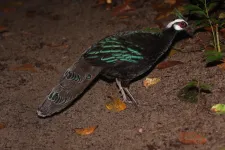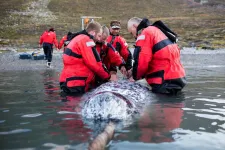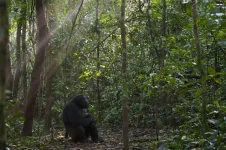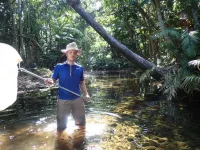(Press-News.org) The lush forests and more than 7,000 islands of the Philippines hold a rich diversity of life, with 258 bird species who live nowhere but the Philippine archipelago. A new study from University of Utah researchers suggests that, due to deforestation and habitat degradation, more bird species may be endangered that previously thought - including species that may not have been discovered yet. The study is published in Frontiers in Ecology and Evolution.
"Our study provides a roadmap for not only which species may warrant heightened conservation attention," says Kyle Kittelberger, a doctoral student in the University of Utah School of Biological Sciences, "but which traits a species may have that can help inform if it may likely be more at risk of extinction."
Birds of the Philippines
Located in Southeast Asia, the Philippines is considered a global biodiversity hotspot and one of the most biodiverse countries in the world, hosting nearly 600 bird species. A high proportion of the wildlife is endemic to the country, meaning that it is found nowhere else. The Philippines also hosts some of the highest richness of species recently identified as distinct from other closely related species, showing that scientists still have much to learn about the Philippine ecosystems.
Within the last decade the number of endemic species has risen from 172 to 258. This increase of 86 endemic species is more than all the endemic bird species in China (67) or India (75) and more than any country in South America or Africa.
Çağan Şekercioğlu, an associate professor in the School of Biological Sciences who has done ornithological field work in over 90 countries on all continents cannot forget his first visit to the islands.
"When I first visited the Philippines in 2008, I was awestruck by the diversity and especially the endemism of its avifauna but also greatly depressed by the rapid loss of habitat," he says. Excursions into the field took hours due to extensive deforestation. "While looking for rare forest birds in the lowlands of Mindanao, we were literally trying to keep ahead of the loggers that were cutting down century-old rainforest trees within a couple hundred meters of us," he adds. Despite that, in 13 days he saw 161 bird species he had never seen before- and still has 163 bird species to go.
Deforestation, habitat degradation and wildlife exploitation, however, threatens that biodiversity. Southeast Asia, the authors write, is forecast to lose over a third of its biodiversity over the next century. The Philippines in particular ranks 8th in the world for the number of globally threatened bird species.
"There is a pressing need to assess what traits make some species more at risk of extinction than others," Kittelberger says, and use this understanding to help inform conservation efforts."
Traits of threatened birds
To understand the status of Philippine birds, the researchers first determined the bird traits most predictive of extinction risk by correlating bird species' ecological and life history traits, including body mass, diet, elevation range, and clutch size (the number of eggs laid in a nesting season) with their conservation status. A species endemic to the Philippines was significantly more likely to face an extinction risk, they found. Narrow elevation ranges, dependence on forests and high body mass also put birds at risk for extinction.
Then the researchers turned around and evaluated Philippine birds' expected conservation status using those traits, comparing predicted conservation status with the IUCN Red List conservation designations. They found that 84 species were predicted to be in worse shape than their Red List designation, with 14 species predicted to be globally threatened (i.e. vulnerable, endangered, or critically endangered) that aren't currently classified as such.
"We predicted that the Philippine Serpent-eagle and Writhed Hornbill, two species that are not currently recognized as being globally threatened, are respectively endangered and critically endangered," Kittelberger says. "We also predicted that the Palawan Peacock-pheasant, Calayan Rail and Philippine Eagle-owl, three species currently recognized internationally as being vulnerable, are likely endangered species. All these birds therefore warrant heightened conservation attention as they may be more threatened than currently believed."
Lost before they're found
Among the 84 species predicted to be more threatened, 12 were recently recognized as separate species, and three of those were predicted to be "vulnerable."
"The Philippines have a very high level of endemism and it is currently estimated that there are twice as many bird species in the Philippines that have not yet been split and officially recognized, so there is a real risk of losing species before they are described," Kittelberger says.
Kittelberger says that their research can be applied broadly to assess the conservation status of birds throughout the region.
"The most important thing that the Philippines can do to protect birds," Kittelberger says, "is to address the high levels of deforestation, habitat degradation, and wildlife exploitation, and to increase land protection for wildlife and increase funding for conservation efforts."
INFORMATION:
Find the full study here.
Co-authors also include Montague H. C. Neate-Clegg, J. David Blount and Çağan Şekercioğlu of the U's School of Biological Sciences, Mary Rose C. Posa of the California Botanic Garden and John McLaughlin of the University of California, Santa Barbara. The study was supported by the Christensen Fund.
An algorithm can predict when narwhals hunt - a task once nearly impossible to gain insight into. Mathematicians and computer scientists at the University of Copenhagen, together with marine biologists in Greenland, have made progress in gathering knowledge about this enigmatic Arctic whale at a time when climate change is pressuring them.
The small whale, known for its distinctively spiraled tusk, is under mounting pressure due to warming waters and the subsequent increase in Arctic shipping traffic. To better care for narwhals, we need to learn more about their foraging behaviour - and how these may change as a result of human disturbances and global warming. Biologists know almost nothing about this. Because narwhals live in isolated Arctic regions and ...
For many of us, our smartphone has become our ever-present companion and is usually far more than just a phone. Thanks to the constant availability of online content as well as our reachability through messenger services and social networks via our smartphone, this everyday object's potential to distract us is high - at work too. This is why many employers view the use of smartphones during work time with suspicion, and countermeasures taken range from asking staff to refrain voluntarily from using them to banning smartphones in the workplace through an internal agreement. But do such measures actually work and, if so, how?
This is the ...
DURHAM, N.C. - Special diets, exercise programs, supplements and vitamins -- everywhere we look there is something supposed to help us live longer. Maybe those work: human average life expectancy has gone from a meager 40-ish years to a whopping 70-something since 1850. Does this mean we are slowing down death?
A new study comparing data from nine human populations and 30 populations of non-human primates says that we are probably not cheating the reaper. The researchers say the increase in human life expectancy is more likely the statistical outcome of improved survival for children and young adults, not slowing the aging clock.
"Populations get older mostly because more individuals get through those early stages of life," ...
In the majority of insects, metamorphosis fosters completely different looking larval and adult stages. For example, adult butterflies are completely different from their larval counterparts, termed caterpillars. This "decoupling" of life stages is thought to allow for adaptation to different environments. Researchers of the University of Bonn now falsified this text book knowledge of evolutionary theory for stoneflies. They found that the ecology of the larvae largely determines the morphology of the adults by investigating 219 earwig and stonefly species at high-resolution particle accelerators. The study has ...
Osteoporosis researchers at the UVA School of Medicine have taken a new approach to understanding how our genes determine the strength of our bones, allowing them to identify several genes not previously known to influence bone density and, ultimately, our risk of fracture.
The work offers important insights into osteoporosis, a condition that affects 10 million Americans, and it provides scientists potential new targets in their battle against the brittle-bone disease.
Importantly, the approach uses a newly created population of laboratory mice that allows researchers to identify relevant genes and overcome limitations of human studies. Identifying such genes has been very difficult but is key to using genetic discoveries to improve ...
Woods Hole, MA (June 16, 2021) -- Woods Hole Oceanographic Institution (WHOI) climate modeler Dr. Alan Condron and United States Geological Survey (USGS) research geologist Dr. Jenna Hill have found evidence that massive icebergs from roughly 31,000 years ago drifted more than 5000km (> 3,000 miles) along the eastern United States coast from Northeast Canada all the way to southern Florida. These findings were published today in Nature Communications.
Using high resolution seafloor mapping, radiocarbon dating and a new iceberg model, the team analyzed about 700 iceberg scours ("plow marks" on the seafloor left behind by the bottom parts of icebergs dragging through marine sediment ) from Cape Hatteras, North Carolina to the Florida Keys. ...
Researchers from the Max-Planck Institute for Terrestrial Microbiology have discovered a surprising asymmetry in the mating behavior of unicellular yeast that emerges solely from molecular differences in pheromone signaling. Their results, published in the current issue of "Science Advances", might shed new light on the evolutionary origins of sexual dimorphism in higher eukaryotes.
Resemblant of higher organisms, yeast gametes communicate during the mating process by secreting and sensing sexual pheromones. However, in contrast to higher eukaryotes, budding yeast is isogamous: seen through a microscope, gametes of both mating types ("sexes"), MATa and MATα, look exactly the same. Since anisogamy -- difference in size between male and female gametes --was ...
HOUSTON ? The University of Texas MD Anderson Cancer Center's Research Highlights provides a glimpse into recently published studies in basic, translational and clinical cancer research from MD Anderson experts. Current advances include a new combination therapy for acute myeloid leukemia (AML), a greater understanding of persistent conditions after AML remission, the discovery of a universal biomarker for exosomes, the identification of a tumor suppressor gene in hepatocellular carcinoma (HCC) and characterization of a new target to treat Clostridioides difficile (C. difficile) infections.
Utilizing combination therapy for AML
While a majority of patients with acute myeloid leukemia (AML) respond favorably ...
Scientists at Weill Cornell Medicine have developed a computational technique that greatly increases the resolution of atomic force microscopy, a specialized type of microscope that "feels" the atoms at a surface. The method reveals atomic-level details on proteins and other biological structures under normal physiological conditions, opening a new window on cell biology, virology and other microscopic processes.
In a study, published June 16 in Nature, the investigators describe the new technique, which is based on a strategy used to improve resolution in light microscopy.
To study proteins and other biomolecules at high resolution, investigators have long relied on two techniques: X-ray crystallography ...
A new rubber band stretches, but then snaps back into its original shape and size. Stretched again, it does the same. But what if the rubber band was made of a material that remembered how it had been stretched? Just as our bones strengthen in response to impact, medical implants or prosthetics composed of such a material could adjust to environmental pressures such as those encountered in strenuous exercise.
A research team at the University of Chicago is now exploring the properties of a material found in cells which allows cells to remember and respond to environmental pressure. In a paper published on May 14, 2021 in Soft Matter, they teased ...








